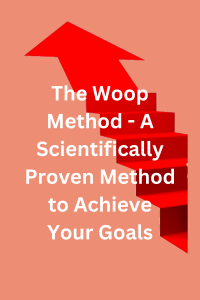
WOOP is a research-based method you can start applying right away to achieve your goals.
WOOP is an acronym that stands for Wish, Outcome, Obstacle, Plan. It’s a method for achieving goals, setting preferences, and changing habits that is based on 20 years of sccientific research in the science of motivation. The WOOP method was created by Gabriele Oettingen, a psychology professor at New York University and the University of Hamburg who has been researching self-regulation and future-oriented thinking for many years. She’s author of the book, “Rethinking Positive Thinking: Inside the New Science of Motivation“.
Below you’ll discover what WOOP is and how you can apply it in your own life to achieve your goals and change your habits.
Positive Thinking Is Not Enough
Although positive thinking is an important first step in achieving your goals, research has shown that positive thinking, without more, is not enough. Just thinking about a positive future saps energy needed for the achievement of your goal. This is because the positive feelings that you get from thinking about achieving your goal make you complacent, so you fail to take the necessary action to actually achieve your goal.
In order to be effective, positive thinking has to be combined with addditional steps. These steps include identifying the obstacles you need to surmount in order to achieve your goal–also known as mental contrasting–, and creating an if-then plan for overcoming those obstacles. If-then plans are also known as implementation intentions. Both of these steps are part of the WOOP method, which is what makes the method so powerful.
Benefits of WOOP
The benefits of the WOOP method include the following:
- Clarify your wishes: It can help you to identify what you really want.
- Set Priorities; It will help you to prioritize your goals so that you can focus on the most important ones.
- Identify and overcome obstacles: It involves identifying obstacles and planning how to overcome them.
- Strengthening willpower: It includes implementation intentions, or an if-then plan, which have been shown to strengthen willpower.
WOOP In a Nutshell
Here’s the WOOP method, in a nutshell:
- Wish: Think about a specific goal, or wish, that is challenging but doable.
- Outcome: Specify and imagine the best outcome. That is, imagine that you’ve achieved your goal and think of all the benefits you’ve gained.
- Obstacles: Identify the obstacles which could get in your way as you strive to achieve your goals.
- Plan: Create an if-then plan to overcome the obstacles and achieve your goal.

As I mentioned above, this four-step process works because it combines mental contrasting with implementation intentions. I’ll be discussing these two concepts next.
Mental Contrasting
As I’ve already shared with you, research shows that positive thinking alone is not enough to achieve your goals. Theref0re, Gabriele Oettingen concluded that something else was needed. She hit upon a concept which she named “mental contrasting”. Here’s Oettingen in her own words:
“I reasoned that the best way to get people up and moving was to ask them to dream and then to confront them right away with the realities that stood in the way of their dreams…If I could ground fantasies in a reality through mental contrasting, I might be able to circumvent the calming effects of dreaming and mobilize dreams as a tool for prompting directed action.”
To apply the mental contrasting technique, you compare two things in quick succession: you see yourself achieving your wish in the future, and then you think of the obstacles that stand in your way. When you experience the contrast between something that you want to achieve and something that’s stopping you from achieving it, it brings forth a necessity of action. You internalize that you won’t get where you want to go unless you take action.
Implementation Intentions
I’ve written about implementation intentions before on this blog. An implementation intention is an “if – then” plan (“if situation Y is encountered, then I will initiate behavior Z in order to reach goal X”).
While goals specify what you intend to achieve–e.g., write a novel–implementation intentions specify the behavior you intend to take and the situational context in which you intend to take said behavior. In the case of writing a novel, your implementation intention could be the following: if it’s 6:00 a.m. on a weekday morning, then I will make a bathroom visit, get a glass of water, and sit at my desk to write for an hour.
Because WOOP is a combination of mental contrasting (WOO) and implementations intentions (P), you can think of it as follows:
Mental Contrasting + Implementation Intentions = WOOP
Now you’re going to conduct a WOOP by following the instructions below.
Conduct a WOOP
To conduct a WOOP, you need five to ten minutes of uninterrupted time. You’re going to use that time to follow the four steps below.
First Step: Wish
The first step of the WOOP method is to make a wish. That is, you’re going to set a goal. You’re going to begin by choosing a domain or the area of your life for which you’re going to set a wish or goal–it can be health, work, family, and so on. Then, answer the following questions:
- What is the time frame for fulfilling your wish?
- In the domain and within the time frame you chose, what is your most important wish or concern?
Pick a wish that is challenging but attainable. Also, take a moment to ask yourself whether it’s really a wish that you want to pursue, or if you have other priorities. Once you’ve decided that it’s an important wish that you really want to pursue, and that it’s achievable, write down your wish in 4 to 6 words,
As an example, I chose the health domain. I’m a weightlifter, but for personal reasons I stopped lifting weights about 8 months ago. My wish is to regain the muscle mass I lost.
Second Step: Outcome
The next step is to identify what the best outcome would be if you fulfilll the wish. Ask yourself the following two questions:
- What would be the best thing, the best outcome about fulfilling your wish?
- How would fulfilling your wish make you feel?
Write down your best outcome in 3 to 6 words. Then, take a moment to imagine the outcome. See the outcome as clearly as you can in your mind’s eye.
In my example, the outcome I want is to look and feel strong.
Third Step: Obstacle
The third step is to identify the obstacle within you–such as thoughts, feelings, bad habits, or actions—which could prevent you from achieving the outcome you imagined in the previous step. Ask yourself the following three questions:
- What is it within you that holds you back from fulfilling your wish?
- What is it in you that stands in the way of you fulfilling your wish?
- What is your main inner obstacle?
Write down your inner obstacle in 3 to 6 words. Then, take a moment to imagine your obstacle. See it as clearly as you can in your mind’s eye.
My inner obstacle is lack of motivation. It’s tough to begin lifting weights again, practically from zero, when I haven’t been weightlifting for so many months.
Fourth Step: Plan
The last step is to create an if-then plan by asking yourself this question: What can you do to overcome your obstacle?
Identify one action you can take or one thought you can think to overcome your obstacle. Write it down as an if-then statement: If (name the obstacle) then (write down in 3 to 6 words what you will do to overcome the obstacle).
My plan is to email a friend and ask for support when I feel like I lack the motivation to go down to the gym to lift weights. Therefore, my if-then statement is the following; If I lack motivation to lift weights, then I will email my friend.
I can help myself even further by creating an if-then statement that specifies when and where I’ll be lifting weights: If it’s 9:00am on a weekday, then I’ll go down to the building’s gym to lift weights.
Conclusion
The power of WOOP lies in combining mental contrasting with if-then planning. You begin by contrasting your positive mental image of the outcome you hope to achieve by reaching your goal with an inner obstacle which stands in your way. You then create a plan in the form of an if-then statement to allow you to overcome the obstacle. As I indicated at the top of this post, there’s plenty of research that shows that this method works.
Live your best life by adopting the WOOP method for goal achievement described in this post.









 Marelisa Fabrega is a lawyer and entrepreneur. She holds a Bachelor of Science in Business Administration from Georgetown University in Washington, D.C., as well as a Juris Doctor from the Georgetown University Law Center. You can learn more about her
Marelisa Fabrega is a lawyer and entrepreneur. She holds a Bachelor of Science in Business Administration from Georgetown University in Washington, D.C., as well as a Juris Doctor from the Georgetown University Law Center. You can learn more about her 





